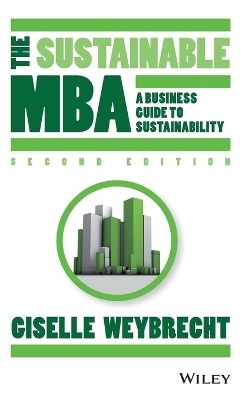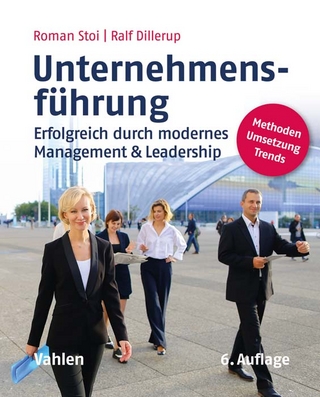
The Sustainable MBA
John Wiley & Sons Inc (Verlag)
978-1-118-76063-5 (ISBN)
Whether you are an employee, a manager, an entrepreneur or a CEO, The Sustainable MBA Second Edition provides the knowledge and tools to help you ‘green’ your job and organization, to turn sustainability talk into action for the benefit of your bottom line and society as a whole.
Based on more than 150 interviews with experts in business, international organizations, NGOs and universities from around the world, this book brings together all the pieces of the business and sustainability puzzle including:
What sustainability is, why you should be interested, how to get started, and what a sustainable organization looks like.
A wide range of tools, guidelines, techniques and concepts that you can use to implement sustainability practices.
Information on how to be a sustainability champion or intrapraneur in your organization including how to sell these ideas to your team and how to incorporate them into any job.
A survey of the exciting trends in sustainable business happening around the world.
A wealth of links to interesting resources for more information.
The Sustainable MBA Second Edition is organized like a business school course, allowing you easy access to the relevant information you need about sustainability as it relates to Accounting, Economics, Entrepreneurship, Ethics, Finance, Marketing, Organizational Behavior and HR, Operations and Strategy.
The Sustainable MBA Second Edition has been updated to reflect global developments in this evolving field to remain the definitive guide to sustainable business. Additional resources to accompany the book are available at www.thesustainablemba.com.
Giselle Weybrecht is determined to make sustainability everybody’s business. Her work is focused on how to inspire and engage the next generation of business leaders to not only understand sustainability, but to put it into practice in ways that make sense for the environment, society and business. She has 15 years of experience working in sustainability in particular with the United Nations but also with governments, universities, NGOs, businesses and entrepreneurs. Giselle has an MBA from London Business School and is a frequent lecturer at universities around the world.
Preface xv
Acknowledgments xix
Part I: Setting the Scene 1
Chapter 1: About this Book 3
Who is The Sustainable MBA for and why should I read it? 5
What you will find in The Sustainable MBA 7
How The Sustainable MBA is organized 9
Ideas on how to use this book 9
Planet Earth fact sheet 10
Chapter 2: What is Sustainability? 13
The basics 14
Other definitions 16
Sustainable development: A global effort 19
Working together: Stakeholders in sustainability 21
Chapter 3: What does this Mean for Business? 23
The business case 24
The sustainability sales pitch 30
Chapter 4: The Sustainability Journey 33
The journey 34
What does a leading company look like? 37
Chapter 5: Getting Started 41
Step by step 42
Getting past internal excuses 48
Part II: the Core Topics 51
Chapter 6: Accounting 55
Why is it important? 56
The key concepts 58
Full or true cost accounting 58
Materiality 61
Key performance indicators 64
Measuring social impact 67
Sustainability in financial statements 68
Integrated reporting 70
Assurance 72
Challenges? 75
Trends and new ideas 76
Bringing it all together 76
Increased disclosure 77
Recognizing unrecognized assets 78
Different forms of reporting 78
Shadow reporting 79
Sustainability reporting 81
Chapter 7: Economics 85
Why is it important? 86
The key concepts 87
Sustainable consumption 88
The commons 90
Externalities 92
Market-based incentives 93
Re-evaluating GDP 97
Emerging markets 99
Challenges? 103
Trends and new ideas 104
Alternative trading systems 104
A new economic model 105
Estimating the cost of inaction 107
From free to fee 108
Valuing future generations 108
Regulatory instruments 109
Environmental valuation 111
Business and the world’s poor 117
Chapter 8: Entrepreneurship 123
Why is it important? 124
The key concepts 125
Social/environmental entrepreneurs 126
Exploring new business models 129
Making changes from within 130
Generating ideas 133
Funding 136
Challenges? 139
Trends and new ideas 140
Merging and selling 140
Microbusinesses 140
Social stock exchange 141
Working with big business 142
Marketing on a shoestring 143
Some advice for entrepreneurs 146
Cooperatives 148
Chapter 9: Ethics and Corporate Governance 153
Why is it important? 154
The key concepts 155
Business and human rights 156
Labor and working conditions 159
Ethics and the individual manager 162
Corporate governance 165
Corruption 167
Bribery 169
The power of media 171
Challenges? 173
Trends and new ideas 174
Transparency and honesty 174
The company of the future 175
Fair trade 176
Crowdsourcing the truth 176
Whistleblowing 177
The role of the CEO 180
Chapter 10: Finance 183
Why is it important? 184
The key concepts 186
Sustainable investment 186
Integrating ESG 189
Fiduciary responsibilities 193
Shareholder engagement 195
Ratings and indexes 198
Project finance 201
Challenges? 203
Trends and new ideas 205
Cross-disciplinary collaboration 205
New landscape for corporate ownership 206
Long-term value 207
The role of the CFO 208
Insurance sector 209
A new kind of bank 209
Microfinance 212
Chapter 11: Marketing 217
Why is it important? 218
The key concepts 219
People 220
Products 224
Price 226
Place 229
Packaging 232
Eco-labels 236
Social marketing 239
Cause-related marketing 242
Challenges? 244
Trends and new ideas 245
Green = inexpensive 246
Eco-iconic to eco-embedded 246
Understanding how people think 247
Communicating with the customer virtually 248
Popups 248
Buycotts 249
The barcode reinvented 249
Advertising dos and don’ts 250
Chapter 12: Operations 255
Why is it important? 256
The key concepts 258
Eco-design 259
‘Green’ chemistry 261
Doing more with less 264
Sustainable technology 265
Suppliers and contractors 268
Transportation 271
Waste management 274
Challenges? 280
Trends and new ideas 280
Inspiration from nature 281
Products that do more 281
Traceability 282
Manufacturing differently 283
Instant feedback 283
Exploring new materials 284
Co-creation 284
Lifecycle assessment 286
Information technology/information systems 290
Chapter 13: HR and Organizational Behavior 295
Why is it important? 296
The key concepts 297
Creating a culture of sustainability 298
Communication 300
Recruiting 302
Employee engagement 304
Motivation and rewards 307
Talent development and training 308
Challenges? 311
Trends and new ideas 312
Linking pay and sustainability 312
Diversity 313
Skills for sustainability 314
Creating great workplaces 315
Changing the way we talk 316
Rise of the CSO 317
Managing change 319
Chapter 14: Strategy 323
Why is it important? 324
The key concepts 325
The wider business environment 326
Understanding where you stand 328
Understanding risks 331
Sustainability strategies 334
Goals and targets 337
Working with others 339
Influencing change 343
Challenges? 346
Trends and new ideas 347
Zero and 100% 347
Getting your customers involved 347
Instant information 348
Strategic philanthropy 349
Transformation of partners 349
Why do initiatives fail? 350
Stakeholder engagement 352
Part III: Tools 361
Chapter 15: Tools for Monitoring, Managing, and Improving Performance 363
Assessments 364
Audits 368
Environmental and social management systems 370
Standards 373
Chapter 16: Tools for Greening Offices and Buildings 377
Steps for setting up office greening programs 379
Buildings 380
Energy 382
Water 383
Waste and recycling 385
Paper 386
Electronics 387
All those other little things 389
Commuting to work 390
Organizing green events and meetings 392
Putting together a green team 394
Performance contracting 397
Part IV: Wrapping It All Up 399
Chapter 17: What Can I Do? 401
As an employee – leading by example 402
How to turn any job into a green job 404
As a consumer – putting your money where your mouth is 405
A simple guide to making choices as a consumer 407
As a citizen – be active in your community 407
Chapter 18: What will the Future Bring? 409
Twenty-one wise words of advice 412
Additional resources: Who, what, where, and how 415
Who: Different groups involved in sustainability 415
What: Sustainability issues 419
Where: Sustainability around the world 425
How: Keeping up to date 430
Endnotes 435
Index 439
| Erscheint lt. Verlag | 23.12.2013 |
|---|---|
| Verlagsort | New York |
| Sprache | englisch |
| Maße | 158 x 231 mm |
| Gewicht | 1111 g |
| Themenwelt | Wirtschaft ► Betriebswirtschaft / Management ► Unternehmensführung / Management |
| ISBN-10 | 1-118-76063-8 / 1118760638 |
| ISBN-13 | 978-1-118-76063-5 / 9781118760635 |
| Zustand | Neuware |
| Haben Sie eine Frage zum Produkt? |
aus dem Bereich


